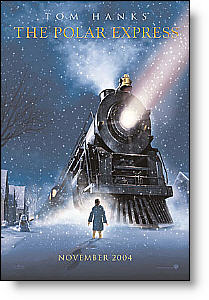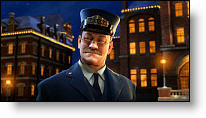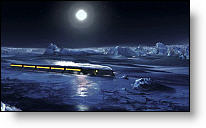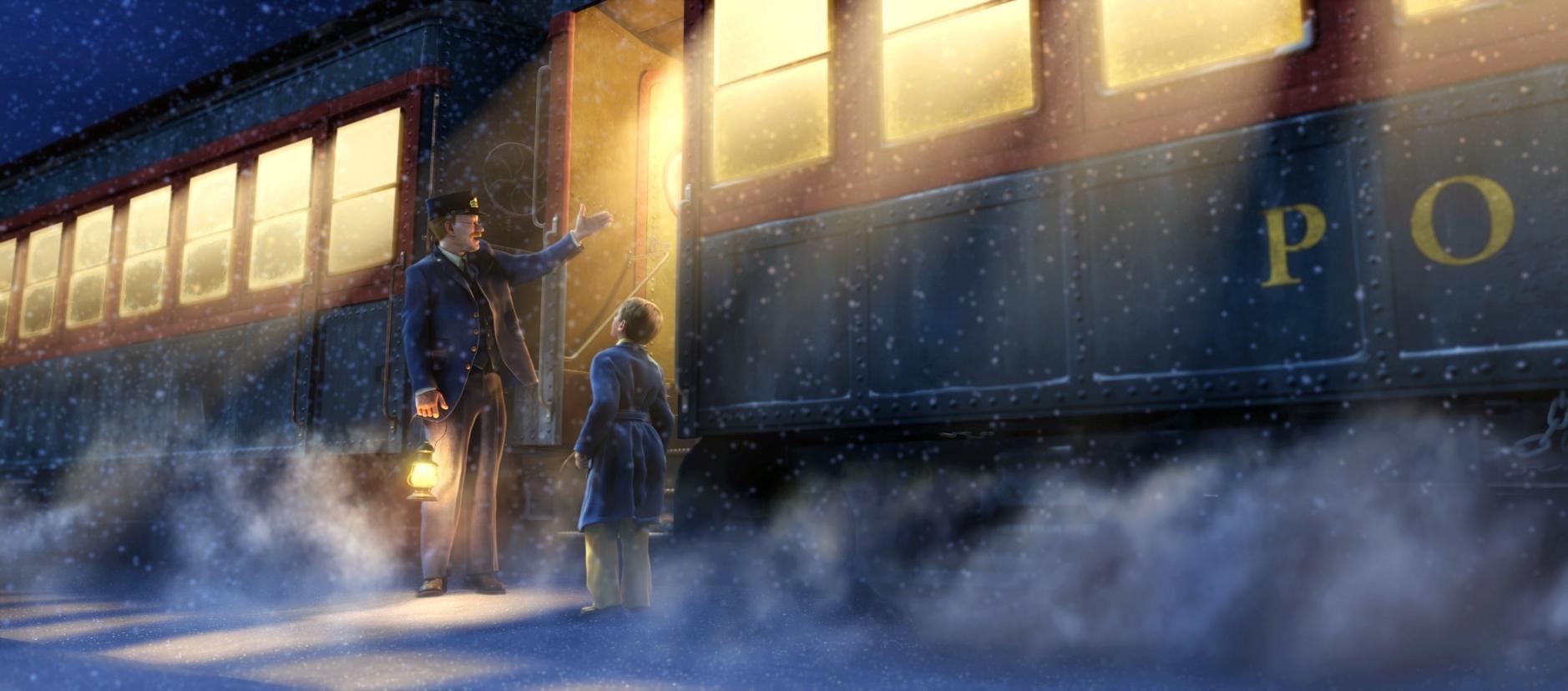The Polar Express
Reviewed by: Michael Karounos
CONTRIBUTOR
| Moral Rating: | Average |
| Moviemaking Quality: |
|
| Primary Audience: | Kids Family |
| Genre: | Animation Kids Family Christmas |
| Length: | 1 hr. 40 min. |
| Year of Release: | 2004 |
| USA Release: |
November 10, 2004 (wide—3,650 theaters) |



| Featuring |
|---|
| Tom Hanks, Chris Coppola, Eddie Deezen, Michael Jeter, Nona Gaye |
| Director |
|
Robert Zemeckis |
| Producer |
| Gary Goetzman, William Teitler, Robert Zemeckis, Steve Starkey |
| Distributor |
“Journey Beyond Your Imagination”
“The Polar Express” is a classic children’s story written and illustrated by Chris Van Allsburg and translated to the big screen with an equally original vision by Robert Zemeckis who directed the movie and co-wrote the screenplay.
Zemeckis adds many original details to the story about a boy who lacks the faith to believe in Santa Claus. On Christmas Eve the parents remark how much the sleeping boy has grown and that it will soon be the “end of the magic” of childhood. The boy hears and wonders at this, even as a magical train stops outside his house. The conductor tells him that their destination is the North Pole, and he gets in a car with other children who are also in their pajamas.
The visuals are luscious and richly-textured. Zemeckis colors the story with the same Baroque surrealism of the book, using a shadowy, Ruebens-like palette. The atmosphere is similar to that in Robert Frost’s “Stopping by Woods on a Snowy Evening”—darkly mysterious and faintly menacing. Fat snowflakes fall throughout the night-time journey as the train passes over high mountains, across an icy desert, and through gloomy, moon-lit forests filled with hungry wolves.
Like many journeys, this one is allegorical. The children learn what their peculiar faults are and how they must overcome them. In this sense, it bears a strong likeness to the “Wizard of Oz” in that it has four characters sharing a journey to a magic city where they receive the knowledge about themselves they were lacking. Thematically, it is even more similar to John Bunyan’s Pilgrim’s Progress because of the underlying spiritual theme of belief.
The premise of the movie is that as one grows old one loses one’s ability to hear the ringing of a bell from Santa’s sleigh. This belief in Santa, unlike a Christian’s belief in God, is at first based on the act of seeing. During the journey the Hobo tells the boy that “Seeing is believing.” When they arrive at the North Pole the boy is saddened that he cannot hear the bells on Santa’s sleigh and that he cannot see Santa through the crowd of elves. In desperation, he repeats to himself “I believe, I believe,” and in that moment, as if in answer to a prayer, Santa appears at his side. Afterwards, the conductor tells him that “Seeing is believing, but sometimes the most real things are those you can’t see.”
At this point the movie transcends the book’s simple story and may remind the Christian viewer that “Faith is being sure of what we hope for and certain of what we do not see” (Hebrews 11:1 NIV). The boy believed before he saw Santa, in much the same way that Hebrews further describes: “And without faith it is impossible to please God, because anyone who comes to him must believe that he exists, and that he rewards those who earnestly seek him” (Hebrews 11:6 NIV). Having earnestly sought and believed first, the boy receives the reward of the bell, which the Conductor said was “the wonderful spirit of Christmas.” Thus, the bell is an emblem of belief, it is the “spirit” of Christmas, and it is the reward that the boy receives from Santa, otherwise described as the “big guy.”
The triangulation of meanings in the bell is echoed by the trinitarian aspect of the boy’s guides. First, the Hobo is a “ghost” who asks the boy if he believes in ghosts. This explains his earlier statement that “Seeing is believing.” If you see a ghost, it must exist, right? Second, it is the Conductor who mediates the boy’s journey from the reality of his unbelieving life to the life of faith in the city of lights where Santa dwells. And third, it is Santa who dispenses his rewards to every boy and girl who believes in him.
Thus, Santa is the Father figure who rewards belief, the ghost is the Holy Ghost who saves the boy’s life, and the Conductor is the Christ-like figure through whom alone the children can go to Santa’s city. Seen in such a light, the movie is a striking Christian allegory of seeking God, finding faith, and earning redemption as a reward.
We also learn that not everyone retains the faith of a child as they grow older and this is an important lesson for children to be taught. However, the boy does retain his faith, and small children should be prepared in advance by their parents to see a Christmas story containing characters whose function and relationship to one another is much like the function of the Trinity in the life of a Christian. By instructing children how the movie functions as an allegory, parents will have a useful object lesson for teaching their children about the allegories in the Bible, such as the sower and the seeds and the prodigal son.
Finally, the message of childhood as possessing a special innocence is famously illustrated by Jesus’ own words when he says, “I tell you the truth, unless you change and become like little children, you will never enter the kingdom of heaven” (Matthew 18:3 NIV). Likewise, the movie and the book may remind us as Christians that unless we retain a child-like innocence we will never hear the “spirit” of Christmas which is the gospel of Jesus Christ. It is through Jesus alone that we receive the Holy Spirit, and it is through His “work” that we are transported on the journey of life to “the city of the Great King” (Matthew 5:35 NIV).
In the book, the North Pole is a “huge city standing alone at the top of the world.” Just as the boy approached the magical city, conveyed there by the ghost and the conductor, so too will we approach the New Jerusalem, conveyed by our own “ghost” and Conductor:
“And he carried me away in the Spirit to a mountain great and high, and showed me the Holy City, Jerusalem, coming down out of heaven from God” —Revelation 21:10 NIV
The movie contains nothing objectionable and is suitable for every age group. Very small children will be entranced by the beautiful visuals of the story, older children will be struck by the magic of a transforming faith, and adults will be gratified by an unusual story which seems so strongly to convey the message of the gospel. The Christian symbols will not be evident to non-believers, but they may give pleasure to believers. Christians of every age will hear the question asked of the little boy—“Someone saved you?”—and will answer in their hearts: “Yes. Jesus saved me,” in words sweet as the ringing of a silver bell.

What is the true meaning of Christmas? Answer


[Excellent!/5]
[Excellent!/5]
[Good/5]
The Christian parallels in the story is a great opportunity to share the true meaning of Christmas. My daughter and I give it four-thumbs up!
[Excellent!/5]
[Good/4½]
Do you think that Tom Hanks realizes any of this? Let’s pray that He will. I cried at the end of the movie. I thank God that He gave me parents who allowed me to enjoy the fantasy of Christmas, although secondary to the true meaning, the birth of our Lord and Savior, Jesus Christ. I look forward to seeing this again, with our teen age son and my husband.
[Better than Average/5]
[Good/5]
I was, to my delight, terribly wrong. Those who describe this movie as allegorical describe it well. I first thought that I was stretching things, but upon reflection and reviewing other’s observations, realize that this movie, whether intentional or not, does indeed have an allegorical quality. I saw belief shown as requiring faith as well as the essence of the trinity, the Christian journey with its ups and downs (contrast the serving of hot chocolate with the consequence of not having a ticket.)
In the end I found it delightful and did not want the movie to end. I was torn between being bothered at the similarities shown between Santa and God the Father, and loving the allegory that shows the love of the Father in that way. I recommend the movie’s allegorical side be used only when sure to be understood. Eight of my nine children saw it, the older ones caught the allegorical side, the littles did not and we chose not to share that at this time. To them, Santa is still something “fun” that people like to pretend about at Christmas time but we do not.
[Good/5]
[Better than Average/5]
[Excellent/5]
[Good/5]
The graphics and animation are AMAZING, but somewhat dark at times. My 12 year old son said “I think a kid 5 and under would get scared at some parts of the movie, especially the ‘doll scene’.” I thought that was very observant. As stated above, if you have a sensitive child, there are a fair amount of scary moments.
[Good/4]
[Better than Average/3]
The theme of friendship was the most clear message portrayed through the little boy from the “other side” of the tracks. They could have done so much more with the Hobo, and I wish they would have left out the doll scene, as well as the rock-n-roll bit with the elves at the end. If you are expecting a secular Christmas show, then you’ll probably enjoy this for a one time view on the big screen.
[Good/3½]
[Better than Average/5]
[Good/5]
[Average/5]
[Better than Average/3]
[Good/4½]
I was also disturbed by the encounter with the menacing hobo ghost. The whole idea of having a scary ghost in a movie for young children seemed out of place to me. Much of the film seemed to have a rather dark quality. Although the technical effects were marvelous and the computer generated characters seemed almost real, the plot failed to really hold our attention.
I completely missed the Christian allegory until I read the above review after seeing the movie. When I explained it to my 9 year old son, he said, “I don’t think Santa Clause makes a good symbol for God, and the train conductor was too mean to be Jesus.” I agree with him. I must say, though, that he thought the intense action was cool and that some of the characters were funny. By the end of the movie, my 5 and 6 year old girls were enjoying the show, as well. Overall, the children liked it, but I was unimpressed by the lack of a more concise story line, and I thought the Christian allegory was too obscured to be very meaningful for a young child.
[Better than Average/4½]
[Good/4½]
[Better than Average/4]
[Average/1]
The graphics are amazing and without flaw. What artistry! I was very impressed; in fact at a glance I thought it was a regular movie and not animated.
I found parts of the story disturbing; i.e., the ghost on the roof; it was a creepy kind of movie; I don’t know how to explain it; it was like when the Holy Spirit nudges you and tells you something isn’t quite right; the overall hue of darkness and “unknown” prevailed from beginning to end and lastly the worship and homage paid to Santa at the North Pole when he appeared. It bothered me to see him so literally worshipped. No one mentioned Jesus, the real reason for the holiday at all! It is purely secular, down to the last jingle. Will I buy it? Absolutely not. One other thing, I took our 4 yr old to see it and we don’t do santa just Jesus at Christmas—since we saw this movie that’s all she talked about was Santa. I found it confused her about what we had raised her to believe. We have 5 children, and it is not my plan for any of the others to see it… regardless of age. This is YET another lesson to me to preview any movie before letting my children see it… when will I ever learn?
[Good/2]
Moral rating: Offensive / Moviemaking quality: 4½
[Excellent/5]
[Good/4½]
[Excellent/5]
[Better than Average/3½]
[Good/4½]
[Good/5]
[Better than Average/4]




My Ratings: [Good/5]